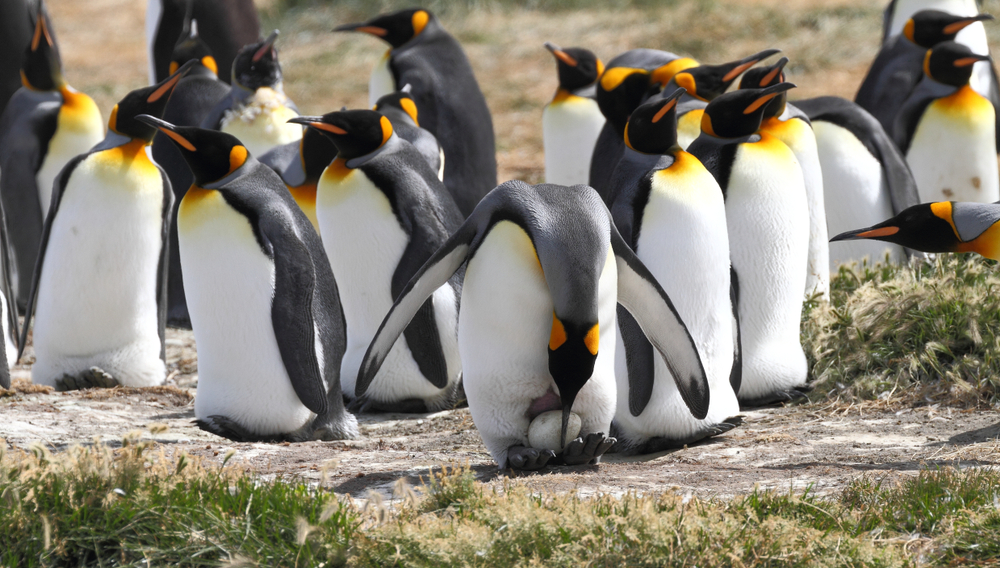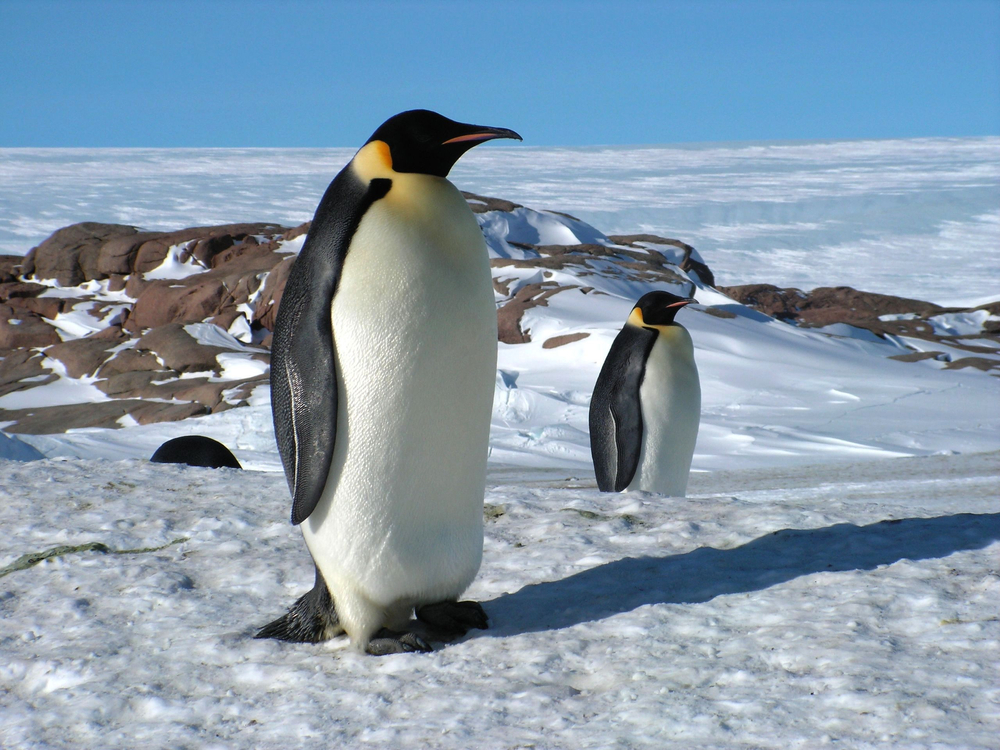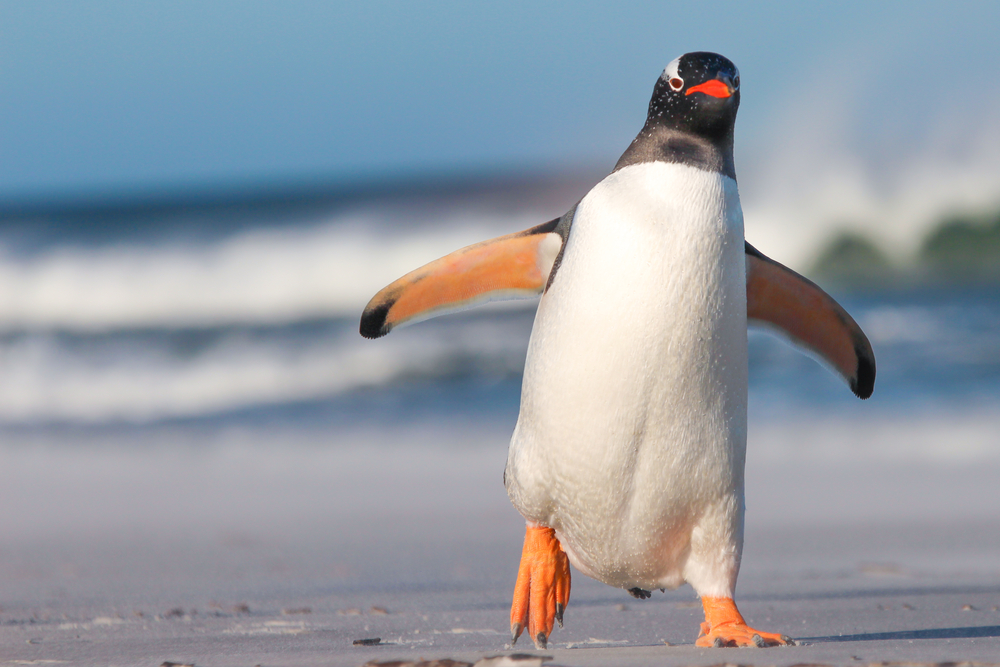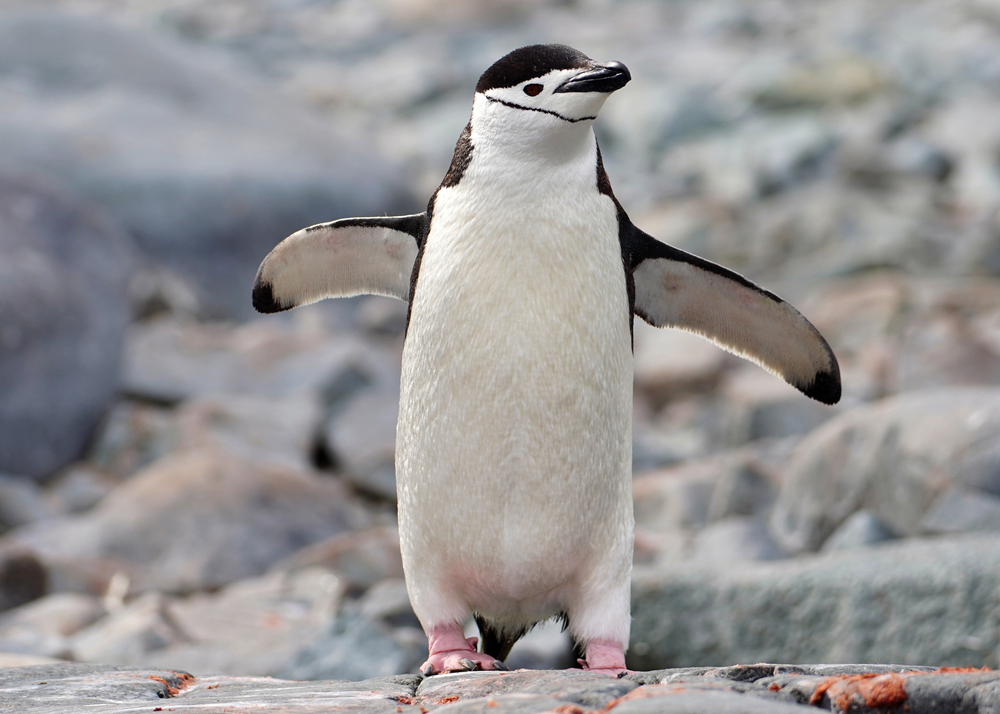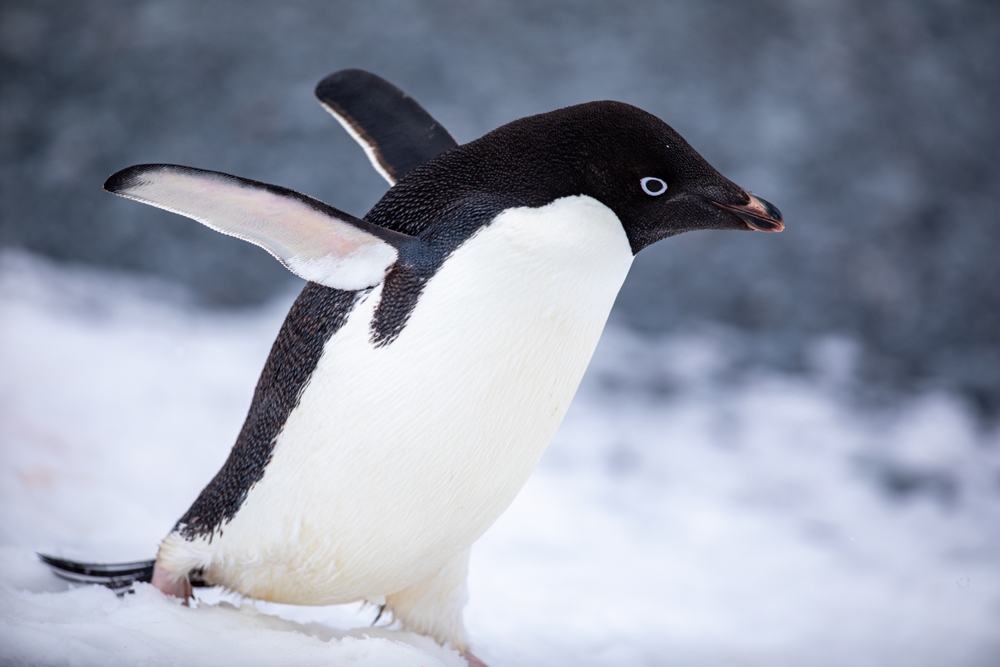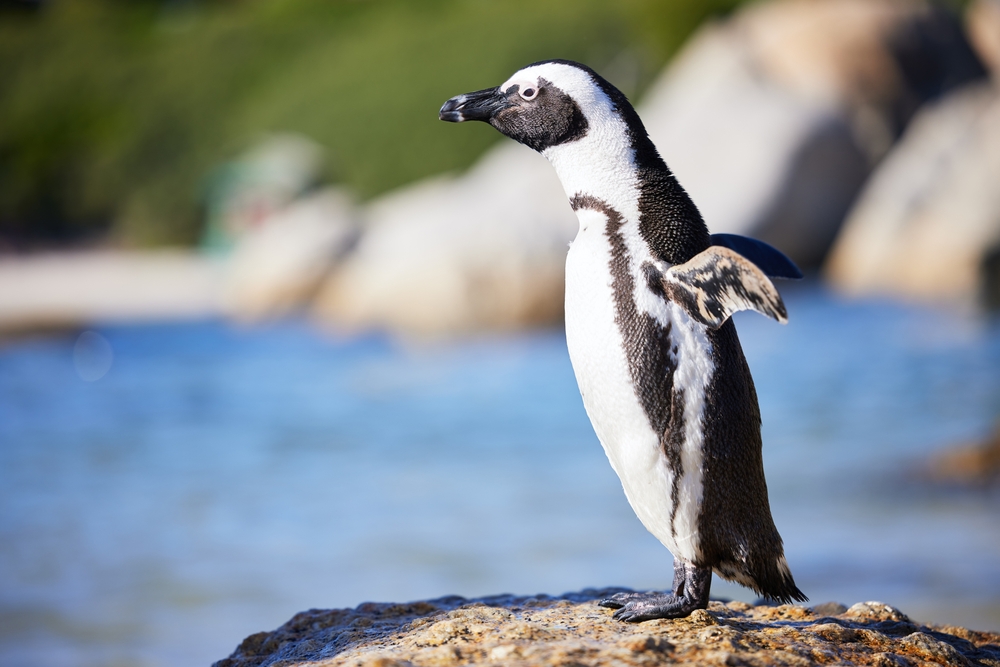The King Penguin’s closest relative is the Emperor Penguin (Aptenodytes forsteri). Both belong to the genus Aptenodytes, sharing tall stature, bright golden plumage, and incubation of eggs on their feet rather than in nests.
About
The King Penguin (Aptenodytes patagonicus) is the second-largest penguin species, belonging to the Spheniscidaefamily, and a close relative of the Emperor Penguin. Native to sub-Antarctic islands, it is found in large colonies on South Georgia, the Falkland Islands, Crozet Islands, and other remote territories where cool climates and ice-free shores provide ideal breeding grounds.
Standing about 90 centimeters (35 inches) tall and weighing 11 to 16 kilograms (24 to 35 pounds), the King Penguin is striking in appearance. It has a sleek black back, white belly, and silver-grey mantle, complemented by vivid orange-gold patches on the sides of the head and upper chest. This regal coloration, combined with their upright stance, gives them an elegant, dignified presence.
King Penguins are skilled divers, reaching depths of over 300 meters (984 feet) in pursuit of fish, squid, and krill. They often forage far offshore, sometimes traveling hundreds of kilometers to locate food. Unlike many penguin species, King Penguins breed on sub-Antarctic beaches rather than icy terrain, relying on the surrounding rich waters to sustain their young.
Their breeding cycle is unusually long, lasting 14 to 16 months. Pairs lay a single egg, which is incubated on the parents’ feet beneath a brood pouch, much like Emperor Penguins. Because of this extended cycle, most pairs breed only once every two years. Chicks, known as “oakum boys” due to their fluffy brown plumage, often remain in crèches for protection while awaiting parental feedings.
The King Penguin is classified as Least Concern, with stable populations, though local colonies face threats from climate change, overfishing, and ecosystem shifts.
Graceful, resilient, and social, King Penguins are a signature species of the Southern Ocean, admired for both their beauty and their extraordinary life cycle.
Physical Characteristics
King Penguins are the second-largest penguin species, distinguished by their elegant stature and striking golden-orange plumage.
-
Coat/Plumage: Their back, head, and flippers are dark gray to black with a silvery sheen, while the chest and belly are pure white. Bright golden-orange patches adorn the sides of the head, throat, and upper chest, fading into pale yellow.
-
Face: The head is sleek and black, with long, teardrop-shaped orange ear patches that extend down the sides of the neck. The bill is long and slender, black with a vivid orange stripe along the lower mandible.
-
Body: Tall, streamlined, and torpedo-shaped, designed for long-distance swimming and endurance diving. A thick fat layer provides insulation in cold waters.
-
Flippers: Stiff and powerful, used like wings to propel them swiftly through the ocean.
-
Feet: Black, webbed, and strong, adapted for swimming and supporting them during long periods standing on land.
-
Tail: Short and wedge-shaped, used for balance when standing upright.
Size:
-
Height: About 28 to 39 in (70 to 100 cm).
-
Weight: Typically 24 to 40 lbs (11 to 18 kg), with seasonal variation—heavier before breeding and fasting periods.
The King Penguin’s striking orange and golden plumage, combined with its tall build, makes it one of the most recognizable penguin species. They are second in size only to the Emperor Penguin and are highly adapted for life on sub-Antarctic islands.
Reproduction
The reproductive cycle of King Penguins is unusual among penguins, spanning more than a year and adapted to sub-Antarctic environments.
-
Mating and Courtship:
-
King Penguins are monogamous within a breeding cycle, with pairs often reuniting for multiple seasons.
-
Courtship involves synchronized calls, mutual displays of head movements, and bill lifting to reinforce pair bonds.
-
Breeding occurs on sub-Antarctic islands, with colonies forming on beaches and flat plains.
-
-
Egg Laying and Incubation:
-
The female lays a single egg.
-
Instead of building nests, both parents incubate the egg by balancing it on their feet and covering it with a brood pouch of abdominal feathers.
-
Incubation lasts about 54 days, with parents alternating shifts of 6 to 18 days.
-
-
Chick Development:
-
Chicks hatch covered in brown down and are cared for by both parents.
-
For the first month, the chick is kept on the feet and brooded continuously.
-
Parents feed chicks through regurgitation of fish and squid.
-
-
Crèche and Extended Cycle:
-
After about a month, chicks form crèches for warmth and safety while parents forage.
-
Because of the lengthy rearing period, the full breeding cycle lasts 14 to 16 months, meaning King Penguins cannot raise chicks every year.
-
King Penguins’ extended breeding cycle and brood-pouch incubation are distinctive features that set them apart from most penguin species. This slow strategy ensures chicks are well-fed and prepared for independence in a harsh sub-Antarctic environment.
Lifespan
King Penguins, the second-largest penguin species, thrive on sub-Antarctic islands where they endure long breeding cycles and harsh climates. Their lifespan reflects both natural challenges and human care.
-
Lifespan in the Wild:
King Penguins typically live 15 to 20 years in the wild. Survival rates are lowest during the juvenile stage, as many chicks and fledglings fall prey to predators or suffer from starvation before reaching adulthood. -
Lifespan in Captivity:
In well-managed zoos and aquariums, where they are protected from predators and given reliable food supplies, King Penguins may live longer, sometimes exceeding 25 years.
Threats to the King Penguin:
-
Predation: Chicks and eggs are preyed upon by skuas, giant petrels, and sheathbills, while adult penguins face predation from leopard seals and killer whales at sea.
-
Food Availability: Their survival depends on the abundance of small fish and squid. Overfishing and climate-driven changes in prey distribution can reduce food availability.
-
Climate Change: Warming oceans and shifting currents may displace key fish species, forcing adults to travel farther to feed themselves and their chicks.
-
Human Disturbance: Growing ecotourism on sub-Antarctic islands can disturb colonies if not carefully managed.
Conservation programs under the Convention for the Conservation of Antarctic Marine Living Resources (CCAMLR) and marine protected areas help sustain King Penguin populations, which are currently stable but vulnerable to climate change impacts.
Eating Habits
King Penguins are specialized hunters that rely on the cold, nutrient-rich waters of the Southern Ocean for food.
-
Diet:
Their primary prey includes small schooling fish (especially lanternfish), along with squid and some krill. Lanternfish can make up more than half of their diet. -
Foraging Strategy:
King Penguins are excellent pursuit divers, using their strong flippers to chase prey underwater. They commonly dive to depths of 330 to 1,000 ft (100 to 300 m), but are capable of reaching over 1,600 ft (500 m) on deeper foraging trips. -
Hunting Behavior:
They forage at sea for days or weeks at a time, swimming long distances between feeding grounds. Group foraging sometimes occurs, especially when targeting dense schools of fish.
During the breeding season, adults must balance long-distance foraging trips with returning to feed their chicks. -
Feeding the Young:
Parents store food in their stomachs, sometimes forming an oily, nutrient-rich substance, which they regurgitate to feed their chicks.
Because of the long breeding cycle, chicks are often left fasting for extended periods during winter while parents forage far offshore. -
Seasonal Variation:
In summer, King Penguins feed closer to colonies, with lanternfish dominating their diet. In winter, they may range farther north, where squid and other fish supplement their food supply.
King Penguins’ ability to dive deeper and forage farther than most other penguin species allows them to exploit prey unavailable to many competitors, but it also makes them highly sensitive to changes in ocean ecosystems.
Uniqueness
The King Penguin (Aptenodytes patagonicus) is a striking and highly distinctive penguin species, second in size only to the Emperor Penguin.
-
Second-Largest Penguin: Reaching nearly 39 in (100 cm) tall, they are smaller than Emperor Penguins but much larger than Gentoo, Adélie, or Chinstrap Penguins.
-
Brilliant Plumage: Their golden-orange patches on the head, neck, and chest give them a regal appearance unmatched by most penguins.
-
Extended Breeding Cycle: Unlike other penguins, their reproductive cycle lasts 14 to 16 months, so they do not breed annually. This long cycle ensures prolonged parental care.
-
No Nests: King Penguins do not build nests. Instead, they incubate their single egg on their feet under a warm brood pouch, similar to Emperor Penguins.
-
Deep Divers: They are among the deepest-diving penguins, regularly reaching depths over 1,000 ft (300 m) in pursuit of lanternfish and squid.
-
Massive Colonies: Some colonies number in the hundreds of thousands, making them spectacular wildlife spectacles on sub-Antarctic islands.
-
Adaptability: Their wide range across the sub-Antarctic gives them greater flexibility than many penguins confined to Antarctica.
The King Penguin’s size, vivid coloration, extended breeding strategy, and ability to form immense colonies make it one of the most remarkable and charismatic penguin species in the world.
Be the First to Share Photos of This Species.
FAQ’s
1. What is the species closest to the King Penguin?
2. How does the King Penguin compare to other penguins?
King Penguins are the second-largest penguin species, smaller than the Emperor Penguin but larger than Gentoo, Adélie, and Chinstrap Penguins. Unlike most penguins, they have an extended breeding cycle lasting more than a year. They are also among the deepest divers, feeding mainly on lanternfish at depths greater than 1,000 ft (300 m).
3. What national parks provide an opportunity to see the King Penguin?
King Penguins breed on several sub-Antarctic islands, many of which are protected areas:
-
South Georgia and South Sandwich Islands (UK Overseas Territory) – home to vast King Penguin colonies.
-
Crozet Islands and Kerguelen Islands (French Southern and Antarctic Lands) – important marine reserves with major populations.
-
Falkland Islands (Islas Malvinas) – colonies protected by local wildlife reserves.
-
Macquarie Island (Australia, UNESCO World Heritage Site) – a key conservation stronghold.
These parks and reserves provide the best opportunities to view King Penguins in the wild.



































































